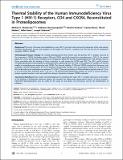| dc.contributor.author | Zhukovsky, Mikhail A. | |
| dc.contributor.author | Basmaciogullari, Stéphane | |
| dc.contributor.author | Schwartz, Olivier | |
| dc.contributor.author | Pacheco, Beatriz | |
| dc.contributor.author | Wang, Jiping | |
| dc.contributor.author | Madani, Navid | |
| dc.contributor.author | Haim, Hillel | |
| dc.contributor.author | Sodroski, Joseph Gerard | |
| dc.date.accessioned | 2012-03-01T01:41:30Z | |
| dc.date.issued | 2010 | |
| dc.identifier.citation | Zhukovsky, Mikhail A., Stéphane Basmaciogullari, Beatriz Pacheco, Liping Wang, Navid Madani, Hillel Haim, and Joseph Sodroski. 2010. Thermal stability of the human immunodeficiency virus type 1 (HIV-1) receptors, CD4 and CXCR4, reconstituted in proteoliposomes. PLoS ONE 5(10): e13249. | en_US |
| dc.identifier.issn | 1932-6203 | en_US |
| dc.identifier.uri | http://nrs.harvard.edu/urn-3:HUL.InstRepos:8296057 | |
| dc.description.abstract | Background: The entry of human immunodeficiency virus (HIV-1) into host cells involves the interaction of the viral exterior envelope glycoprotein, gp120, and receptors on the target cell. The HIV-1 receptors are CD4 and one of two chemokine receptors, CCR5 or CXCR4. Methodology/Principal Findings: We created proteoliposomes that contain CD4, the primary HIV-1 receptor, and one of the coreceptors, CXCR4. Antibodies against CD4 and CXCR4 specifically bound the proteoliposomes. CXCL12, the natural ligand for CXCR4, and the small-molecule CXCR4 antagonist, AMD3100, bound the proteoliposomes with affinities close to those associated with the binding of these molecules to cells expressing CXCR4 and CD4. The HIV-1 gp120 exterior envelope glycoprotein bound tightly to proteoliposomes expressing only CD4 and, in the presence of soluble CD4, bound weakly to proteoliposomes expressing only CXCR4. The thermal stability of CD4 and CXCR4 inserted into liposomes was examined. Thermal denaturation of CXCR4 followed second-order kinetics, with an activation energy (E\(_a\)) of 269 kJ/mol (64.3 kcal/mol) and an inactivation temperature (T\(_i\)) of 56°C. Thermal inactivation of CD4 exhibited a reaction order of 1.3, an E\(_a\) of 278 kJ/mol (66.5 kcal/mol), and a T\(_i\) of 52.2°C. The second-order denaturation kinetics of CXCR4 is unusual among G protein-coupled receptors, and may result from dimeric interactions between CXCR4 molecules. Conclusions/Significance: Our studies with proteoliposomes containing the native HIV-1 receptors allowed an examination of the binding of biologically important ligands and revealed the higher-order denaturation kinetics of these receptors. CD4/CXCR4-proteoliposomes may be useful for the study of virus-target cell interactions and for the identification of inhibitors. | en_US |
| dc.language.iso | en_US | en_US |
| dc.publisher | Public Library of Science | en_US |
| dc.relation.isversionof | doi://10.1371/journal.pone.0013249 | en_US |
| dc.relation.hasversion | http://www.ncbi.nlm.nih.gov/pmc/articles/PMC2954141/pdf/ | en_US |
| dash.license | LAA | |
| dc.title | Thermal Stability of the Human Immunodeficiency Virus Type 1 (HIV-1) Receptors, CD4 and CXCR4, Reconstituted in Proteoliposomes | en_US |
| dc.type | Journal Article | en_US |
| dc.description.version | Version of Record | en_US |
| dc.relation.journal | PLoS ONE | en_US |
| dash.depositing.author | Pacheco, Beatriz | |
| dc.date.available | 2012-03-01T01:41:30Z | |
| dash.affiliation.other | HMS^Surgery-Brigham and Women's Hospital | en_US |
| dash.affiliation.other | HMS^Pathology | en_US |
| dash.affiliation.other | HMS^Pathology | en_US |
| dash.affiliation.other | SPH^Immunology and Infectious Diseases | en_US |
| dash.affiliation.other | HMS^Pathology | en_US |
| dc.identifier.doi | 10.1371/journal.pone.0013249 | * |
| dash.authorsordered | false | |
| dash.contributor.affiliated | Pacheco, Beatriz | |
| dash.contributor.affiliated | Haim, Hillel | |
| dash.contributor.affiliated | Wang, Jiping | |
| dash.contributor.affiliated | Madani, Navid | |
| dash.contributor.affiliated | Sodroski, Joseph | |


